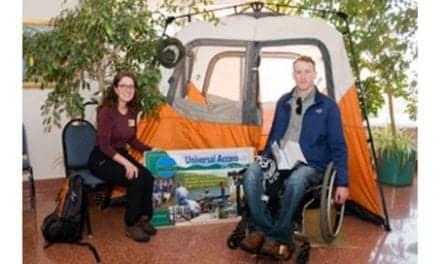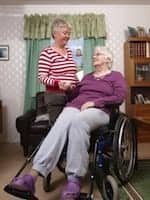
This screened-in porch (viewed from the living room) is a seasonal extension of the living room. Note there is no level change between one space and the other, so rolling or walking is an “Easy Come and Easy Go and Easy Everything in Between.” (Image courtesy of Susan Bachner Consulting LLC)
Baby Boomers with varying abilities are the force behind the latest major trend in housing known as universal design. Universal design1 with its emphasis on comfort, safety, and accessibility enables “aging in place” with ease and great living design. It includes products as well as structures. “By 2029, when all of the Baby Boomers will be 65 years and over, more than 20% of the total US population will be over the age of 65.”2
Occupational therapists and some physical therapists who are stakeholders in home modification strategies may find themselves associated with projects devoted to enabling clients to live in their own homes for as long as possible: to age in place. Among these strategies, universal design is a concept often applied to remodels and modifications. Homes that employ universal design are marked by ease of use, attractiveness, and adaptability. There are limitless possibilities for products and features in the home. However, a home should only be considered universally designed if has at least one stepless entry, flush thresholds, clear floor spaces for maneuvering, and interior doorways with a minimum of 32 inches of clear space, along with bathroom and kitchen features appropriate for people with or without mobility issues. Equipment and appliances should also be easy to see, understand, and operate. These adaptations help maintain or improve independence and quality of life.
Some professional organizations, universities, and other groups offer certifications that are specifically related to aging in place, environmental modifications, and universal design.1 While the various entities’ center of attention is focused on the same broad topic, there may well be a different emphasis associated with the respective programs and certifying bodies. For example, the American Occupational Therapy Association’s Specialty Certification in Environmental Modifications (SCEM) is sought only by occupational therapists, while the National Association of Home Builder’s Certified Aging-in-Place Specialist (CAPS) designation is earned by building professionals, therapists, designers, and others. Nevertheless, all should collaborate with understanding of the respective contributions and be able to bring complementing perspectives to the table.
What is the occupational therapists’ perspective? “The job of occupational therapists facilitating the home modification process is to ensure that the solutions conform to the residents’ abilities, needs, and wants. They must begin each project, therefore, by evaluating the configuration of people who live in and visit the home and looking at the way in which the environment and the activities performed there come together. This concept is an important part of occupational therapy’s theoretical basis.”3
The following case-based example illustrates why and how a universally designed home modifications project “works,” and also shares an occupational therapist’s (OT) evaluation and contributions to the scope of work.
The homeowners, both in their 70s, wanted to create spaces that would both match their current abilities and
accommodate whatever issues lay ahead. While in good health, they still experienced common age-related physical issues such as painful joints and back stiffness, mixed needs in regard to lighting (one spouse had cataracts), and balance challenges that put them at an increased risk of falling.
Concern for falling was a significant piece in the dialogue with the clients, and for good reason: An estimated 1.8 million falls led to an emergency department visit among Americans age 65 years or older in 2000, and falls are the leading cause of death from injuries among older persons. The literature supports the judgment that one desirable approach for reducing falls is to modify the home in order to eliminate or abate common hazards.5
The couple’s goal was to “age in place” by creating the capability of only first floor living (in a two-story house). To sustain meaningful engagement in daily living activities, they needed to eliminate environmental barriers such as steps, narrow spaces, and poor accessibility. Therefore, entering the home without steps, enabling guests of all abilities to utilize the powder room, creating enough space for both a master bathroom and guest room with full baths, designing a functional kitchen for standing or seated users—all universal design1 goals—was the intent. Aesthetics as well as functional spaces were imperative. Many of the universal design principles were incorporated and guided the various design and product-selection decisions. The clients were hoping to
experience comfort, safety, and ease of use as their unavoidably changing abilities interacted with their home environment.
Problems in the existing home included but were not limited to the front entrance steps, narrow hallways, an outdated and confining kitchen without flexibility or adaptability for use, and a cramped master bathroom with a curbed shower stall. Many of these spaces and products required bending, climbing, reaching, grasping, and rotating.
The home’s bathroom was once such space, and required modifications that anticipated how potential age-related disability might affect toileting and hygiene activities. For example, modifications that support bathroom tasks such as transferring on/off the commode and into the tub/shower needed to be considered. Several devices could be helpful in fulfilling those needs, including transfer seats and grab bars. Rolling commode chairs and shower chairs, too, may be useful for dealing with significant age-related restricted mobility. Having adequate clear floor space to accommodate those potential issues was part of the plan.
Other challenges include the occupant’s ability to find items within restricted closets, or to access the back porch (because of a level change). Accessing the home’s main water shut-off located in the basement of this couple’s home was another vital consideration that demanded modification.

Part of the universally designed remodel involved the creation of a step-less entrance. The option to replace the front entrance steps with both a circular driveway and a gently sloped (1/4” to 1 linear foot) brick walkway to meet the driveway was chosen. Another example of “Easy Come and Easy Go!” This stepless entryway works for individuals of all abilities. (Image courtesy of Susan Bachner Consulting LLC)
For an “easy come and easy go,” the front entrance was modified to become stepless by creating a circular driveway that aesthetically and seamlessly joined the new covered entry porch and door. To complement the elegant look of a circular driveway, a pathway can gently slope toward the entrance of a home and accommodate wheelchair or walker access without hinting to passersby that an occupant may be disabled. This couple felt that a pathway (slope of 1:20) was, in fact, the right choice for them.
For “easy everything in-between,” the first floor walls were essentially demolished. By bumping out for the master bedroom and repurposing existing rooms to allow for universally designed living spaces, the former master bedroom, for example, became the master bathroom.
Part of effective planning means anticipating the possibility a homeowner may eventually rely on a mobility device because of impairment caused by age-related disability. In these cases, room-to-room access can be made easier with automatic door-opening systems operated by push pads mounted on walls or mobility devices. A stair-mounted wheelchair lift can also provide a home’s occupants access to the additional living space of a second floor. Overhead lifts, wall-to-wall lifts, and portable lifts can be useful in the event a homeowner is affected by age-related mobility impairment. These devices can be easily accommodated in homes where universal design has been followed, and added as needed.
In the case-based example of the couple in their 70s, the new kitchen’s features eliminated or significantly reduced the necessity for bending, reaching and grasping. The modifications that resulted in those improvements included:
1) Raising the dishwasher 9 inches off the finished floor;
2) Providing a lever-handled sink faucet;
3) Choosing a French-door refrigerator-freezer for easy
refrigerator access;
4) Creating a microwave drawer location with easy access whether standing or seated; and
5) Installing pull-out cabinet drawers and a pantry.
The remodeled powder room sink offered access to those walking or rolling into the room; and the vanity height allowed proper knee space for a seated user. The comfort-height commode and clear floor space added to accessibility.

Curbless shower in master bathroom: Note there is no shower stall curb requiring a person to step up and over – it is perfectly flush with the bathroom floor. The fold-down bench is there when someone needs it and folded out of the way when not. The hand-held shower head is within easy reach of the bench. There are two drains to assure water containment: one centered in the shower and the other, a trench, at the glass French doors. (Image courtesy of Susan Bachner Consulting LLC)
The new master bathroom exemplified universal design1; it blended functionality and beauty. The gradually sloped curbless 4- by 6-foot tile shower (¼ inch to one linear foot) significantly reduced risks for falling—weight-bearing (and balancing) on one foot to step over a curb would no longer be required for entry as it had been with the former curbed shower. The handheld shower head with pause button was located within an easy reach from the fold-down bench and supplemented the fixed head’s water source. The vanity was designed to allow wheelchair accessibility at any future point by simply removing the undersink cabinet’s few screws.
The adjacent bump-out bedroom was designed for furniture and clear floor space with three-sided exposures to the private back gardens. The new screened-in porch became a seasonal extension of the family room; the door’s threshold was ½ inch beveled. Another important consideration in the plan was moving the main water supply shut-off from the basement to a closet on the first floor.
As with any therapists’ interventions, best practice included checking to see if the goals were achieved. In this situation, the homeowners were ecstatic over the outcome. In addition to adding value to their home, they saw these modifications as a “coming together” between their abilities, the environment, and their activities of daily living. The following is a partial summary of the benefits:
A) Safety increased markedly by opening spaces and providing features to eliminate all elevation changes into and throughout the first floor: A stepless front entry, 4- by 6-foot curbless shower and access to the screened-in porch. Concerns related to balance issues and risks of falling were alleviated.
B) Bending and reaching difficulties due to occasional pain and stiffness were eased by having raised the dishwasher 9 inches off the finished floor. Each room gained one electric outlet at
26 inches off the finished floor for vacuum plug ease.
C) Replacing knobs with lever handles at sinks and doors eliminated grasping problems.
D) Achieving flexible illumination by installing dimmable lighting throughout the home allowed each person to customize the brightness to individual needs.
E) Welcoming visitors with mobility devices became possible with the stepless entrance. Everyone had access to all first-floor rooms because interior doorways were widened to 32 inches and hallway widths to 48 inches. The accessible powder room allowed a front approach to the sink. The comfort height toilets were welcome additions. The master bathroom vanity was designed for easy conversion if wheelchair accessibility became important.
F) Relocating the main water shut-off to a first-floor closet eliminated the need to navigate steep basement stairs.
G) Aesthetically beautiful—a charitable entity requested inclusion of this home for their fund-raising tour.
Financing for this and similar projects usually involves out-of-pocket expenditures. Home equity loans are sometimes used as a source of cash with the added benefit that interest might qualify as a tax deduction. “It also helps to compare the cost of needed changes with other options, like moving.”4 Some products or modifications, although expensive, may turn out to be the least costly option. There are some who say the ability to feel right at home defies a price tag. However, as with any significant financial decision, it is always wise to consult with a financial advisor or accountant.
Susan Bachner, MA, OTR, FAOTA, SCEM, CAPS, CEAC, of Susan Bachner Consulting LLC (www.susanbachnerconsulting.com), has 50 years of clinical and consultation experience with people facing physical, mental and cognitive challenges. Bachner’s home adaptations consulting business was established in 2000 and is dedicated to creating environments that promote safety, accessibility, comfort, and social participation utilizing universal design1 principles. She frequently writes and speaks on the topic of universal design and aging-in-place. For more information contact [email protected]





